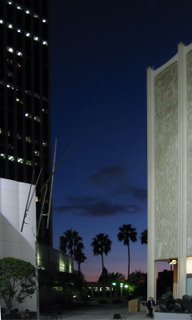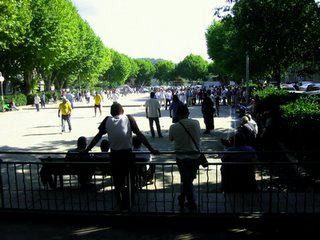
left: our ridge, twilight
BUT NOT WITHOUT FIRST seeing three more plays, eating one more fabulous meal, getting lost once or twice. All that in two days!
Okay, dinner first: That was at Campanile, an old favorite unvisited too many years — unless you count an occasional breakfast. Mark Peel, who was an assistant of Lindsey’s years ago at Chez Panisse, opened this fine restaurant in Charlie Chaplin’s old house, half a block off Wilshire Blvd. on La Brea Avenue, more years ago than I like to think. At one time it was fabulous; for a while it seemed to me to have slipped a bit; now it’s right back where it began, with Mark at the helm and a menu that’s engaging, enterprising, excellent.
We began with squab on risotto, white truffles shaved over it, the rice cooked just so, the squab tender but meaty. A Bibb lettuce salad refocussed things, with the snap of lemon juice lifting the cool crisp leaves out of the ordinary. And then, for me, duck breast, grilled, served with a sort of compote of winter vegetables including chestnuts. With this a St. Amour 2003, direct and mature and fruity, and then a glass of Sean Thackeray’s Pleiades, to complement the duck’s complexity.
The drive from Glendale, where we stay on these semiannual theater outings south, to places like Campanile or the LA County Museum (where we’d been the day before), is easy and enjoyable. Down to Los Feliz, across on that avenue past the strangely dumpy Mulholland fountain to Western, down Western to Third or Fifth, down La Brea or whatever. The drive back, after that dinner, was less direct, for Hollywood likes to post two street-names on the same post. So we turned east a block too soon, discovered the mistake, and turned north to explore a narrow street, cluttered with unnecessarily large cars parked wherever they could find a place, and winding through what must have been a relatively upscale neighborhood, since all we could see were high board fences, automatic yard lights, and an occasional Beware the Dog. No matter: it took us right to Los Feliz.
That afternoon we had seen William Inge’s Picnic, beautifully detailed and lovingly portrayed by A Noise Within. I hadn’t seen it before, oddly enough, and was struck by its resonances — Thornton Wilder’s Our Town, as Gaye pointed out, but, more personally than that, my own childhood, or at least one year of it, spent in a small town in northeastern Oklahoma. I wasn’t old enough to share Madge’s problems, or even Millie’s — adolescence was still a few years away — but the yearning, the perplexities, the awareness of all kinds of isolation, even the apparent war between physicality and intelligence — all that was indeed resonant.
Yesterday, Sunday afternoon, we saw the third play currently in repertory at A Noise Within: Ibsen’s The Master Builder. What a play! You can read it in so many ways: the tragic birth of Modernism out of Romanticism; Ego as the enemy of Community; Ambition as the tragically flawed child of Success...
And the production, and the performance, completed a cycle of three plays very satisfactorily, for the problem with Thursday’s Othello — an overly detailed and therefore distracting Iago — was a great virtue in this Builder: a brittle, complex, riveting Halvard Solness: both roles were taken by Geoff Elliott, who was also, with his wife Julia Roderiguez-Elliott, co-director of both plays.
A footnote to the comments, below, on Dwight Baquie’s performance of the role of Othello: what we saw was in fact only his fourth performance in the role, and the first had been the previous day. He stepped into the part in a student matinee, played it again Wednesday night, and then repeated it Thursday in another matinee before the performance we saw. It’s odd he’d never played it before, because he was born for the role; when he has it in hand it will be memorable for only good reasons — and perhaps Elliott’s Iago will be in better balance.
Yesterday after the Master Builder matinee we drove down to Los Angeles for dinner with friends: Dan the painter, Tony the actor. Dan made a delicious bolognese to put on pasta, and we had a bottle of four-dollar Hungarian cabernet, and then we walked over to Evidence Room, a sort of storefront theater club, to see David Greenspan’s She Stoops to Comedy, postmodernly, neo-cubistly taking on Pirandello with half an eye trained also on Restoration comedy, cutting back and forth between narrative and commentary, and generally making great fun out of confusions of gender, role-playing, Art and Life, as they develop out of the six characters — one of them Tony — in search of a play. I’d see it again given half a chance.
And what else. Glendale’s cute little Spanish-Mission train station, where we left John and Gaye to Amtrak. Dan and Tony’s magnificent dining room, crafted, table, floor, walls, ceiling and all, out of an ash-tree that came down in their front yard. Urartu Coffee, as nice a little community coffeehouse as you could want, a block off Glendale’s troubled Brand Avenue, now in the throes of yet another redevelopment.
And a long walk, having lost my bearings in spite of Lindsey’s correct directional instinct, in the dark night, cluttered with rejected furniture and distressed cars on the lawns and boulevard strips, peopled with the unemployed and the dubiously employed, lit by the occasional sweeps of a hovering helicopter’s searchlight, warm with spent passions and delayed hopes — yet oddly intimate, friendly, and nostalgic: or perhaps I was still basking in William Inge’s Picnic.


